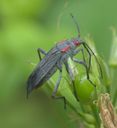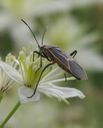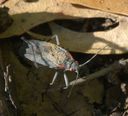Soapberry Bugs
Serinethinae
Classification
- Phylum: Arthropoda
- Subphylum: Hexapoda
- Class: Insecta
- Order: Hemiptera
- Suborder: Heteroptera
- Infraorder: Pentatomomorpha
- Superfamily: Coreoidea
- Family: Rhopalidae
- Subfamily: Serinethinae
Pronunciation
How to pronounce Serinethinae: /sɛrˈɪnɛθɪniː/
These audio files are automatically generated. While they are not always 100% accurate, they are a good starting point.
Images






Summary
Serinethinae, commonly known as soapberry bugs, are a subfamily of brightly colored insects that specialize in feeding on the seeds of plants within the Sapindaceae family. They exhibit a characteristic coloration and have adapted to diverse environments.
Physical Characteristics
Distinctive black-and-red color scheme among North American rhopalids.
Identification Tips
Look for brightly colored seed-eaters with a prominent black-and-red coloration, particularly in the genera Boisea and Jadera.
Habitat
Most diverse in tropical regions of both hemispheres; found in areas with soapberry plants.
Distribution
North America, Southern India, Eastern and Southern Africa, primarily New World (mostly neotropical) regions for Jadera.
Diet
Seeds of various Sapindaceae plants, including maples and soapberry trees.
Life Cycle
Adults feed on seeds which are also the primary food source for nymphs during their growth and development.
Reproduction
Dependent on the availability of seeds from Sapindaceae plants for successful reproduction.
Ecosystem Role
As seed-eaters, they play a role in the ecological interactions of their habitats, particularly in relation to their host plants.
Evolution
Diversity resulted from adaptive radiation on their host plants, which have evolved defenses such as toxic seeds.
Similar Taxa
Misconceptions
Some may incorrectly associate them with harm, but they are primarily seed-eaters and not harmful to humans.
Tags
- Serinethinae
- soapberry bugs
- Rhopalidae